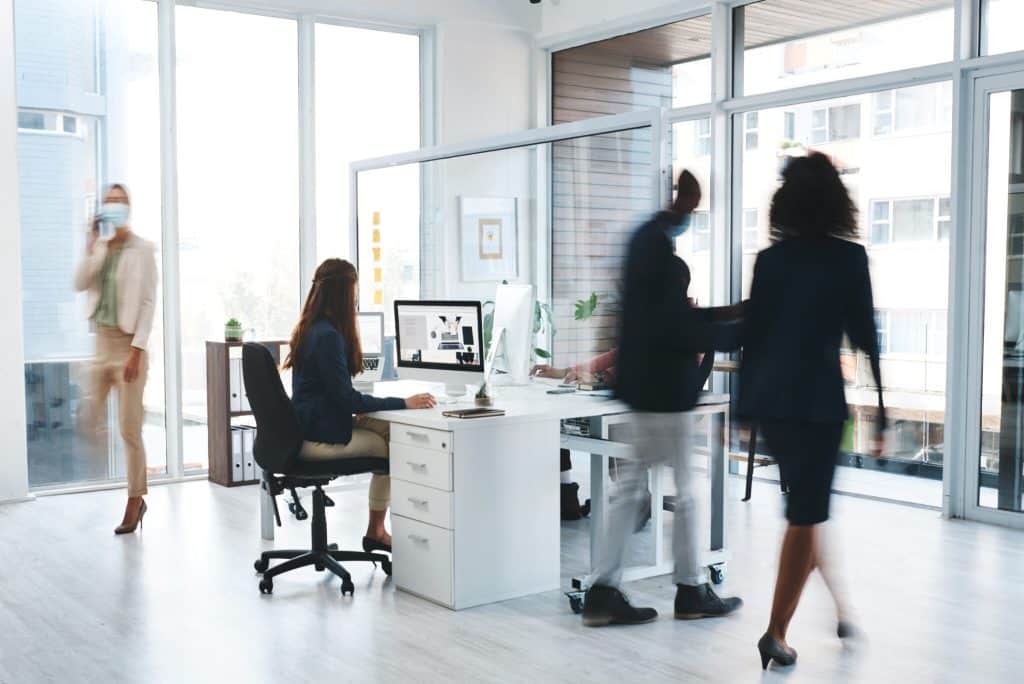
Options for Redesigning, Reconfiguring and Reimagining your Office Space in the Age of COVID
November 3, 2020
When it comes to making changes to your office environment that will minimize the public health risk and make it as safe as possible for your team to return to work, companies are all over the board. Some decision-makers have concluded they need more space and have worked to spread out their layout. Others anticipate fewer full-time employees in the office and are actually downsizing.
While there is no “right” answer when it comes to the best way to redesign, reconfigure and reimagine your office space in a post-COVID environment, it is important to be knowledgeable about the options that are available to you. Whether you go it alone or work with commercial office experts and space planning professionals, taking smart, strategic, cost-effective steps to safeguard your space and people is part of the new normal in pandemic (and post-pandemic) landscape.
Divide and conquer
One of the most popular changes some companies are making is to install more permanent partitions throughout the office. Moving from low cubicles in open floor plans to higher cubicle walls, or adding new glass or plexiglass partitions between workspaces, is a relatively cost-effective way to lower the risk of airborne transmission. Some companies are using even more creative and flexible solutions to section off individual spaces, such as movable dividers and partitions. And, of course, there is a much higher demand for individual offices for more employees.
Less is more
One of the simplest (and most affordable) ways to make meaningful safety changes to your office environment is to simply reduce or remove the volume of furniture. This is especially important in spaces like lobbies and waiting rooms, where downsizing from six chairs to two, for example, creates some social distancing and inherent limits to the number of people that willing to congregate in a space.
Policy and protocols
Some of the most important changes companies are making aren’t about the office itself, but the way it is used. In other words, this is less about brick-and-mortar physical changes and more about redesigned policies and practices. That might include things like staggered shifts, rotating schedules to limit the number of employees in the office at any one time, or eliminating shared workstations.
Common spaces and amenities
Some companies are transforming their meeting rooms and conference spaces into new, safely-spaced-out workspaces for two or three employees. This allows a new use of group space as a way to expand the working footprint of the office without the expense or disruption of actually expanding or moving to a physically larger office. Other common spaces, such as office kitchen or dining areas, are being repurposed or reimagined in ways that limit the number of people who can be in them at one time. We are, however, starting to see some experimentation with reopening public and company-wide amenities like gyms—albeit with newly enhanced safety and cleanliness protocols and occupancy limits.
Smart and safe
There are a number of changes that can be made in office and in buildings that could have a potentially significant ROI in terms of public health and safety for a fairly modest investment of time or resources. Those include things like establishing floor markings to indicate a safe, six-foot distance in public areas; placing hand sanitizer dispensers throughout the building at entrances and exits, high traffic spaces, elevator banks and other high-touch areas; adding self-cleaning elevator buttons; and changing filters for building or office HVAC systems more frequently. Introducing more outside air into building or office circulation can also help. One caveat to consider is that some changes of this nature will require additional permitting, the cost and timelines of which should be taken into account.
Wait-and-see mode
While companies are wise to be making the kind of thoughtful and cost-effective changes to their office layouts and practices described above, we are seeing a lot of tenants in “wait and see” mode—beyond those initial steps of creating barriers and distance. Decision-makers are trying to do more with less and avoid big investments and costly missteps until they know more about what the weeks and months ahead might look like. One way to make sure that the steps you take today are proportionate, effective, and appropriate is to utilize a program like Farman’s new Real Estate Services Program. The service offers a suite of specialized services designed to help companies better understand their post-COVID office space needs. It also helps companies design and implement the kinds of creative and flexible changes that will protect their people and office environment, and position them for success not just in the near- or mid-term, but for many years to come.
Related Posts

Crain's Notable Commercial Real Estate Leaders
Blog Post | July 17, 2024
Click Here for Full Article Scope of work: Andrew Gutman worked his way up at myriad commercial real estate firms to lead Farbman Group, Farbman companies, 30 million rentable square feet...
Read More
What’s a Broker to Do? Tight Vacancy and High Interest Rates Mean No More Slam-Dunk Deals
Blog Post | July 9, 2024
Brokers Have to Get Creative — as in Create Deals Brokers need to study their local markets like never before and know who the top buyers and sellers are, stressed...
Read More
Connect Midwest Multifamily Panelists on 2024 CRE Trends
Blog Post | June 26, 2024
CRE experts from the recent Connect Midwest Multifamily conference in Chicago reflected on their experience and the importance of meeting customer needs in business. As the age-old mantra says,...
Read More